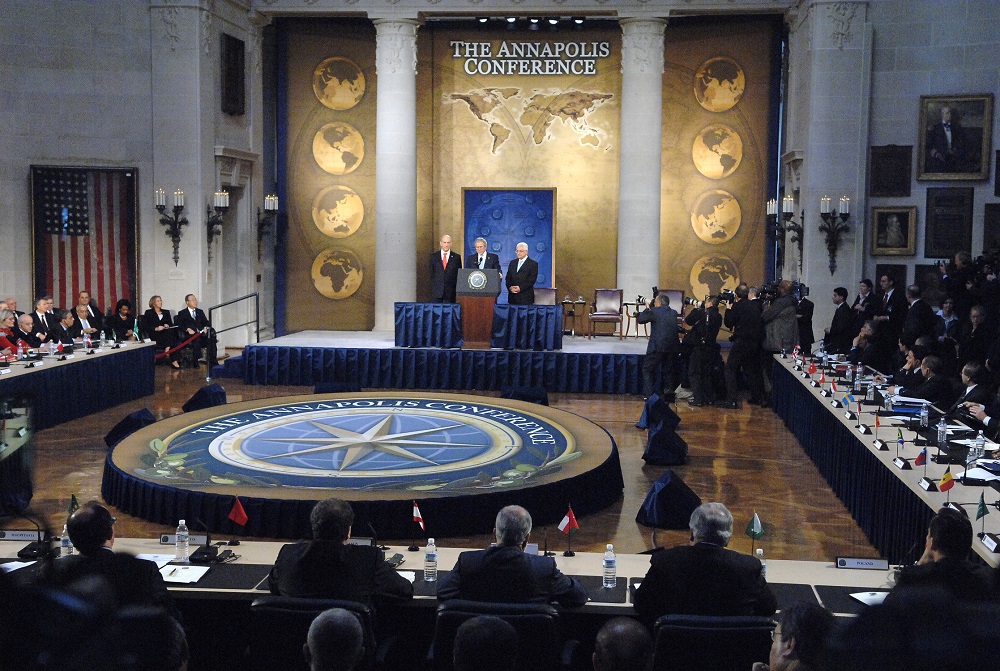Israel’s Annapolis Nightmare
In early April, newly sworn-in Israeli Foreign Minister Avigdor Lieberman made waves during his first speech asForeign Ministerwhen he announced that Israel is not obligated by agreements reached at the 2007 Annapolis Conference. Israel is only obligated, he said, to abide by the 2003 Road Map and its terms must be followed precisely and in order. While these two plans for Israeli-Palestinian peace have the same goal of a two-state solution, they go about achieving that aim through very different methods.
The Roadmap was presented by President Bush to Prime Minister Sharon and PLO Chairman Yasser Arafat in April of 2003, and the Israeli government subsequently adopted the document albeit with fourteen reservations.The U.S.-backed peace proposal set a series of benchmarks designed to move Israelis and Palestinians over a three-year period to the creation of a Palestinian state that would exist in peace with Israel.
Basically, the document envisioned a bottom-up performance-based series of confidence-building measures taking place step-by-step in three phases. First and foremost, the agreement required that Israeli security demands be met. That involved the Palestinians ending terrorism and incitement against Israel, dismantling terrorist organizations, conducting comprehensive political reforms in preparation for responsible statehood, and recognizing Israel’s right to exist in peace and security. For its part, Israel was to ease restrictions on the movement of people and goods, withdraw from Palestinian areas occupied after September 28, 2000, freeze settlement construction, and dismantle settlement “outposts” erected after March 2001. The second stage involved establishing a Palestinian state within temporary boundaries, and the third involved final status negotiations on the “core issues”of permanent borders of a Palestinian state, refugees, settlements, determining the status of Jerusalem, and international recognition for both Palestine and Israel.
In a letter exchanged in April 2004 between Bush and Sharon, Bush confirmed that “Palestinians must undertake an immediate cessation of armed activity and all acts of violence against Israelis anywhere, and all official Palestinian institutions must end incitement against Israel.” He also confirmed that the Palestinians “had to act decisively against terror by dismantling terrorist capabilities and infrastructures” and to undertake “comprehensive and fundamental political reforms.” In the letter, he recognized as well that existing major Israeli population centers on the West Bank prevented “a full and complete return to the armistice lines of 1949” meaning that a future Israeli-Palestinian land-swap could not be ruled out. The difficult “core issues” in Phase 3 however, would be left to the final phase of the settlement. That is, the Palestinians first had to prove by their actions and in accordance with established benchmarks that they accepted Israel’s right to live in peace and security as a pre-condition to dealing with the “final status issues.”
The Annapolis Declaration of November 2007 turned the Roadmap on its head. It envisioned a top-down process primarily because the Palestinians expressed no desire to fulfill their Phase 1 Roadmap responsibilities relating to ending their terrorist activities and incitement against Israel. Recognizing this, Annapolis attempted to reverse the process by demanding that the Phase 3 “final status issues” of the Roadmap be negotiated first and immediately.
Syrian Foreign Minister Walid al-Moallem was not happy with Lieberman’s response: “We need to see how the United States will deal with an Israeli government representing the extreme right, and continues to reject the two-state solution” he told Lebanon’s As-Safir newspaper. So, let’s think about this. President Bush once said that a “Palestinian state will never be created by terror” yet, at Annapolis, he insisted that a Palestinian state should be created regardless of terror. Apparently, President Obama agrees.
The problem is that the years of intifada that followed the failure at Camp David in July 2000, not to mention decades of Palestinian deceit and terror have merely reinforced a bitter reality for the Israelis. The Arab-Israeli conflict is not about territory or occupation. In its essence, it’s about wanting to expel or subjugate Jews living in what the Arabs/Persians consider holy Moslem territory anywhere in the Middle East. Itwould beout of the question for Israel to recognize the Palestinian people’s right of self-determination in advance, while the Palestinians refuse to recognize the Jewish people’s right of self-determination.
So, if the Israelis are balking at a two-state solution, their hesitation is based on the realistic prognosis that any Palestinian state under current circumstances would, in the end, be controlled by terrorists and would represent an existential threat to their country. While the US would never countenance a terrorist state contiguous to the continental United States, at Annapolis, it had no qualms in requiring Israel to accept such a threat. No wonder Israel is worried.
Changing the emphasis from the bottom-up, performance-based terms of the Roadmap to the top-down Annapolis process brings to the fore the essence of the Israeli-Palestinian conflict. A two-state solution cannot come to pass unless and until the Arab world reconciles itself to the existence of a Jewish state in the Middle East. Since neither Fatah nor Hamas have shown any inclination to do so, their failure must preclude any discussion on the “final status issues” set forth in the Roadmap. More to the point, both Palestinian organizations are ideologically committed to the annihilation of Israel. And they are not alone. According to a recent Norwegian poll taken by the Fafo Institute for Applied International Studies, 33 percent of Palestinians seek the annihilation of the state of Israel, whether by political means or by force of arms – to be replaced by a single Islamic republic, while another 20 percent favor a united Israeli-Palestinian state to be eventually engulfed by the latter population. That is why the PLO Charter still demands the destruction of Israel, while that of Hamas calls for jihad against Israel and the Jewish people. Acknowledging the right of Israel to exist as a sovereign state in the Middle East would mean acceptance of Jewish historical and biblical ties to their ancient land, and this, the majority of Palestinians are not prepared accept at the present time or for the foreseeable future.
Into this fray comes an Israeli Foreign Minister who has the chutzpah to tell the US, the Europeans and the Arab/Persian world that he intends to put the Palestinians “feet to the fire” by insisting that they comply precisely with the performance benchmarks agreed to in Phase 1 of the Roadmap (ending terrorism, dismantling terrorist infrastructures, ending incitement to terrorism, establishing a stable, responsible civilian government and recognizing Israel) despite the fact that the majority of Palestinians continue to see terrorism as a legitimate form of “resistance” and to seek Israel’s destruction.
Yet, by supporting the Roadmap and demanding that it be strictly enforced, Lieberman has become an international pariah – a man “beyond the pale”, a “hawkish nationalist,” an “ultranationalist” and, for good measure, “a racist.” Former US ambassador to Israel Dan Kurtzer, a long-standing Obama Middle East adviser, warned that “a government headed by Benjamin Netanyahu which included Avigdor Lieberman would be a bad combination for American interests” which would be loath to “embrace a government that included a politician who was defined as a racist.”
But are Avigdor Lieberman’s demands so unreasonable? Whatever happened to the premise that terrorists had to be defeated and the swamps that bred them had to be drained? A return to Annapolis would mean that the policy enshrined in the Roadmap no longer matters and is to be replaced by another policy less focused on achieving “peace” than on maintaining the appearance of a peace “process” which is the primary reason President Bush signed on to Annapolis in the first place. He recognized that it was easier to compel concessions from Israel than to change the fundamental nature of Palestinian society.
In the near future, Israel can expect the Obama administration to restrict U.S. arms exports to Israel in an effort to deny systems that could be used in any attack against Iran or Syria. Israel can also expect pressure to “accept” a two-state solution immediately – that is, a return to the Annapolis Declaration (even though the majority of Palestinians and Israelis, albeit for entirely different reasons, have rejected it) and pressure to accept the Saudi “peace plan” which requires Israel to commit national suicide in return for more hollow promises of “peace” with the Arab world.
Perhaps Foreign Minister Lieberman did not go far enough in explaining his government’s position. It would have been better had he clarified the Israeli position to the Palestinians, the Europeans, and to President Obama in less diplomatic terms – perhaps something like this:
“Tell you what, if you recognize Israel as a sovereign state in the Middle East, prove you are dismantling your terrorist infrastructures, stop sending your suicide bombers into our cities, towns and marketplaces, stop inciting hatred and spreading blood libels through your media, your mosques, your educational system and throughout your society, stop brainwashing your children into believing that the fast track to virgins in Paradise requires them to become human grenades and to murder as many Jews as possible, stop firing missiles at us, stop honoring as heroes Palestinian perpetrators of massacres of Jewish civilians, put your house in order and cease operating like a failed, terrorist state, then we’ll come to the table with an offer that will bring both our societies peace and prosperity.”
Sound reasonable?
Absolutely.
Is that going to happen any time soon?
Don’t hold your breath.



